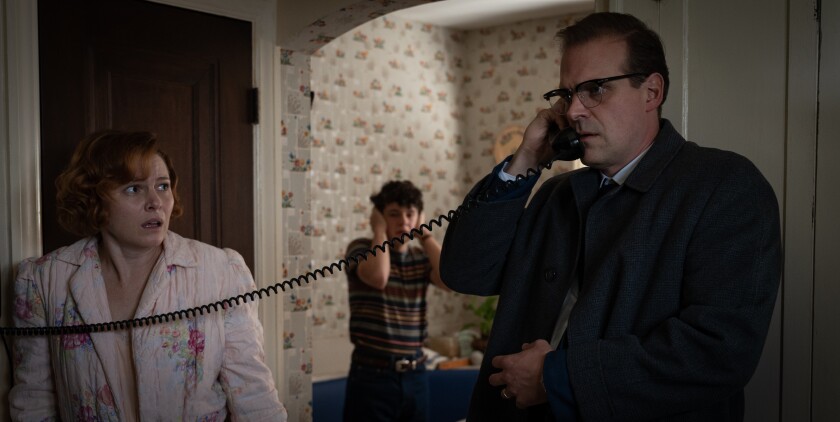Before the main caper in No Sudden Move even begins, we’re given narrative elements that imply a crime film of truly epic proportions: two rival gangs, a desperate gangster looking for a way out, a shady job from a mysterious benefactor, and a codebook full of secrets that threatens to bring the criminal underworld of Detroit crumbling down. The movie’s pace matches these expectations as Curt Goynes (Don Cheadle) and Ronald Russo (Benicio del Toro) race against the clock, unraveling a conspiracy while trying to net an even bigger score. By the film’s end,however, once all is revealed, their score is cast in a different, less renegaded light, forcing these criminals—as well as the audience—to reevaluate their expectations.
I mean that in a good way; it’s always a delight when a film can set you up and then surprise you, all while delivering the most entertaining version possible of its story. No Sudden Move is this to a T, a truly enveloping movie filled with interesting and complex characters that play off of each other spectacularly. Curt, recently released from prison and itching to settle his affairs, rubs up against Ronald, who’s more restrained in what he wants and who he trusts. The two must work together when a “babysitting” job—a.k.a. a hostage situation with a family—goes awry, forcing them to try and find out who hired them and why, if they hope to emerge with any money, let alone their lives.

In addition to the less-than-dynamic duo of the film’s protagonists, there’s also a accountant (David Harbour) who’s been sucked into this whole mess, his wife (Amy Seimetz) who’s forced to take on a stronger role in her family, mob bosses Frank Capelli and Aldrick Watkins (Ray Liotta and Bill Duke), Vanessa (Julia Fox), Capelli’s wife who’s having an affair with Ronald, and a determined detective (Jon Hamm) who’s just trying to make sense of a growing crime scene. All leave their mark on the screen, though it seems to me that Liotta and Hamm could’ve done more with their given characters, and I wish there had been more of Seimetz or Fox.
Directed by Steven Soderbergh and written by his frequent collaborator Ed Solomon, this sprawling story oozes with strong narrative stylistic choices. For example, Seimetz’s limited role as a 50s housewife manages to nearly steal the whole movie because of her character’s intricacies; she’s clearly tied of the performance she has to put on as a women in this time period, and yet is a master at playing the part. She’s almost at home in the company of Curt and Ronald—two men she doesn’t want anything to do with, yet can fall into conversation with them more easily than with her own husband.

No Sudden Move also proves to be a prime example of the visual prowess of Soderbergh as a cinematographer. It’s filled with carefully directed scenes and shots that are a delight for the eyes, though the most distinctive cinematic aspect comes from the camera itself—in that most of the movie is shot with a fish eye lens. This gives every shot a rounded distortion at its edges, and turns the image of anything that moves through the frame into a warped disfigurement. This stylistic choice works with the story being told, as we see the world bend and twist around the characters, almost like it threatens to envelop them completely. It also makes the viewer aware that they are watching something, that they’re removed from what’s on screen and bearing witness to the events that unfold.
The backdrop of the movie itself is no less visually interesting, as No Sudden Move uses a vivid yet gray 1950s Detroit to explore the American automotive industry at a crucial turning point in history. Soderbergh’s had an eye for color in all of his movies, but instead of the rich, saturated looks in the casinos of Ocean’s Eleven, here he plunges the streets and alleyways into blues and deep greens, saving hints of vibrancy for high-class hotspots like clubs and restaurants. The only thing that draws more attention to itself in the settings than the colors are the cars, which prove to be a focal point for the film itself. Through a series of photographs in the beginning we catch glimpses of families taking rides, possibly their first rides, in cars—illustrating how cars are slowly encroaching on American culture as a whole. And at the end, we see why society is being driven down this road, and who benefits from it.

I’ve avoided talking about the plot of this movie beyond broad strokes because I think it benefits immensely from the audience knowing little about what its crooks will get up to during the runtime. No Sudden Move is better appreciated by a viewer who sits back and enjoys the ride, although sometimes storybeats happen at such a breakneck pace that the plot can sometimes be temporarily lost. Even if you miss an important line or two, however, the experience is never severely hampered due to the strong writing for its central characters. Even at its lowest points, No Sudden Move never fails to be at least one of three things: thrilling, delightful, and darkly amusing.
4/5 STARS
